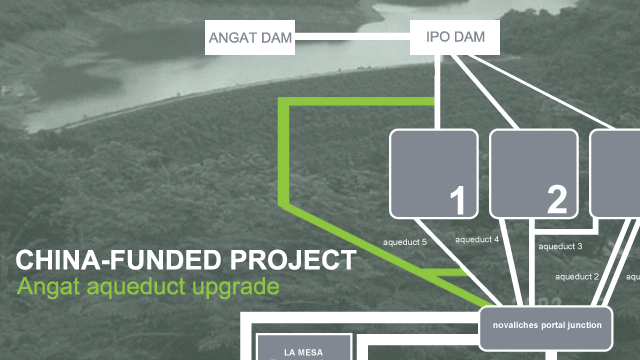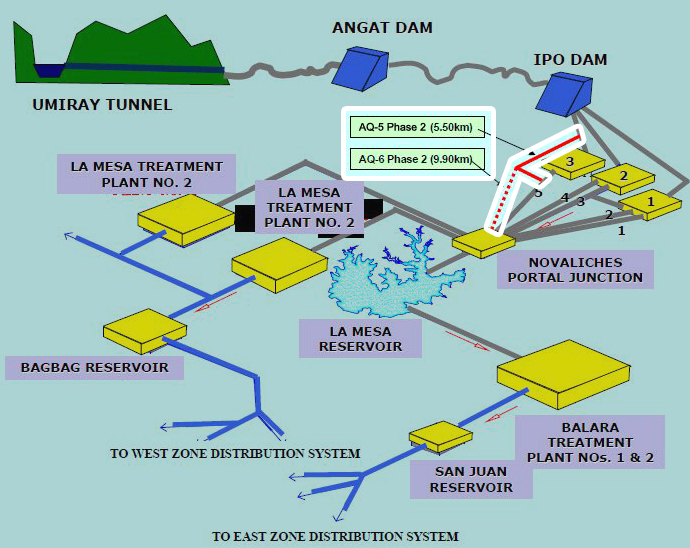SUMMARY
This is AI generated summarization, which may have errors. For context, always refer to the full article.

MANILA, Philippines – The completion of a multi-billion peso project to repair a piece of waterworks is usually not usually a big deal. But when the P6.1 billion Angat aqueduct improvement project in Bulacan province was finished recently, the Metropolitan Waterworks and Sewerage System (MWSS) will mark the occasion with an inauguration on Tuesday, July 17, attended by no less than President Benigno Aquino III, according to water officials.
The project was funded by a US$116-million loan from the Export-Import Bank of China, according to the National Economic and Development Authority (Neda).
Indeed, the event calls for a celebration of sorts. At the heart of the project is the repair of segments 15-kilometer canal, Aqueduct No. 5, which carries about half of the 4,000 million liters per day (MLD) of water from Angat dam to treatment facilities and distribution pipes in Metro Manila.
A new, sixth aqueduct of almost the same length was also completed.

Project financing: from ADB to China
An inspection in 2002 found at least 13 major leaks in Aqueduct No. 5, causing losses of at least 150 million liters a day. Why the repairs and construction of a new water channel took a decade to finish – worsening the water shortage in the capital region brought about by the El Nino weather pattern in the summer of 2010 — highlights the risks when geopolitics, corruption and infrastructure planning mix.
The project was almost scuttled before it could even begin.
The MWSS began construction work on the new aqueduct sometime in 2005 using government funds, and completed the first phase of around 5.5 kilometers by 2006.
The second phase was supposed to be funded with a $70 million Asian Development Bank (ADB) loan. But in January 2007, economic managers of then-President Gloria Arroyo ordered an end to loan talks with ADB and instead sought funding from the Export-Import Bank of China.
The ADB was not pleased: the deal was meant to showcase a new flexible lending scheme for water projects and to signal its commitment to boost resources for the water sector. But it was a time when China was emerging as the Philippines fourth biggest source of official development assistance loans after Japan, the ADB and World Bank.
The past: controversial China-funded projects
Beijing had pledged close to a $1 billion loan to finance the North Luzon Railways (Northrail) project and was in the middle of talks for the $329-million loan to fund the Philippines’ National Broadband Network project. Manila was also drawing closer to Beijing geopolitically, especially after the two countries signed a joint marine seismic agreement in 2005 to study the seabed under disputed waters in the South China Sea.
But a kickbacks scandal surrounding the award of the NBN project to Chinese telecommunications supplier ZTE erupted soon after. Romulo Neri, then the director-general of the Neda, which clears large infrastructure projects, accused Benjamin Abalos, the former elections chief, of trying to offer him a P200 million bribe to approve the broadband project.
Joey de Venecia, ZTE’s rival proponent and son of the speaker of the House of Representatives at that time, accused Miguel Arroyo, the president’s husband of bullying him into withdrawing his competing offer for the NBN project. He alleged that Abalos and the president’s husband of maneuvering behind the scenes to get the government to award the project to ZTE in return for hefty commissions. Abalos and Arroyo have denied the allegations but the Office of the Ombudsman last year filed graft cases against them, along with the president, with the Sandiganbayan, the anti-corruption court, where the cases are still being heard.
The controversy forced Arroyo in September 2007 to suspend many infrastructure projects funded by China, including the Angat aqueduct rehabilitation project. The NBN and many other projects were eventually scrapped.
The Angat project was spared but talks with China on the project resumed only in 2009 when the controversy from the kickback allegations quieted down.
Current project: Angat water channel and bids for it
MWSS held what it called a “limited competitive bidding” among 3 Chinese firms for the project in the middle of 2009, and awarded the contract to China International Water & Electricity Co (CWE), a unit of the Chinese state firm behind the Three Gorges Project in the Yangtze River.
Loan negotiations between the Philippines’ Department of Finance and the Export-Import Bank of China, were completed in 2010, paving the way for the implementation of the project that year.
Water officials in 2010 said the limited bidding process was compliant with the public bidding requirement mandated by the procurement law. Earlier China-funded projects came under widespread criticism because of the absence of bidding in the selection of contractors and suppliers.
The past controversies convinced China to agree to a limited bidding among Chinese firms instead of simply nominating the supplier, the officials said.
In spite of China International Water’s reputation as an affiliate of the builder of the world’s biggest hydropower project, its selection was not without controversy.
In February 2011, the Philippine Large Diameter Pressure Pipe Manufacturers Association urged the new MWSS board members appointed by Aquino to rescind the contract. It alleged that limiting the bidding among three Chinese state-owned firms violated the country’s procurement law.
The association also said the contract price was excessive compared to the cost of the first phase of the project which was carried out by three members of the group.
The MWSS board, however, did not act on the association’s recommendation to rescind the contract.
In fact, a senior official of the water agency seems rather pleased about China International Water’s performance. “We’re inaugurating it 8 months ahead of the deadline,” the official said last week.
Moving forward: China and Philippines
The Angat aqueduct project’s timely completion underscores the possibility of positive outcomes when China and the Philippines work together to accommodate each other’s concerns and needs.
What allowed the project to go ahead was when the two sides found a way to select a contractor that satisfied the Philippines’ procurement law. China used to insist on nominating the contract or supplier for projects it was funding.
At a time when most China-funded projects, such as Northrail continue to be stalled, it is a rare project success that the two sides should cherish amid increasingly tense diplomatic relations due conflicting claims over parts of the South China Sea or West Philippine Sea. – Rappler.com
Add a comment
How does this make you feel?
There are no comments yet. Add your comment to start the conversation.